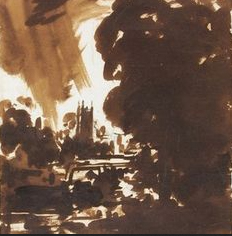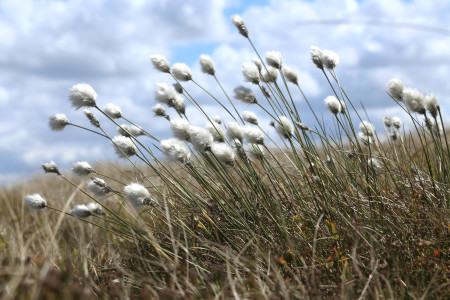Landscape: Europe versus Japan. SW 12/5/17
Cotton grass, Haworth Moor, May 2017
I like to think I inherited a love of landscape from my mother, who came to England from South Africa in her twenties and completely fell for the lush greenness of the Cotswolds and the Lake District. I suspect she had an experience similar to Sylvia Plath visiting Haworth Moor in her twenties and writing home to her mother in America:
How can I tell you how wonderful it is. Imagine yourself on top of the world, with all the purplish hills curving away […] black walls of stone, clear streams from which we drank; and, at last, a lonely, deserted black–stone house, broken down, clinging to the windy side of a hill.
One tends to be reticent about maternal influence in these matters, so it has been very interesting to read Augustin Berque’s Nature, Artifice and Japanese Culture (1993) and its matter-of-fact identification of landscape with nostalgia for the womb. The author points out how metaphors of envelopment run through countless Japanese essays on landscape, and how the Japanese garden makes great play of curvature, hollows and nestling. The mountain (as maternal bosom) is brought into the garden by the arrangement of stones and viewpoints, and it seems to be the depths, the shadows that remain favoured spaces. Proof of this trait in the Japanese character can apparently be found in the mass internal migration that takes place at the annual commemoration of the dead, and at New Year, when tens of millions return ‘home’ to the sato from the city, many of them travelling on special kisei ressha (‘returning home’) trains.
We shall see whether this theory is borne out by our explorations, but there is undoubtedly a different attitude to nature in Japan.
Western ideas of landscape were fundamentally changed by the Romantic revolution from the 1790s onwards, but it looks as though in Japan an unbroken tradition of landscape appreciation goes back to the 10th or 11th century and continues today. The dichotomy can perhaps be explained by religion: Christianity has generally been suspicious of nature; with notable exceptions like St Augustine and Hildegard of Bingen it has been considered pagan, something for humans to overcome in their pursuit of a kingdom ‘not of this world’. At the same time the wilderness was feared and deplored as genuinely dangerous and hostile.
The Romantics turned all that on its head: nature became a source of wisdom and nourishment in itself, and insofar as nature is ‘something we have lost’ since the industrial revolution this has made it even more a touchstone for modern urban populations, whilst they continue to destroy this same nature in pursuit of progress and civilization.
So for us in the West nature is a contested area, with ‘culture’ and ‘nature’, ‘city’ and ‘country’ being terms in continual debate. An approach to ‘landscape’ can take varied forms, and once you add the ingredient of landscape art the whole topic can become quite a challenge. Malcolm Andrews, at the beginning of Landscape and Western Art problematises the subject quite well:
A landscape, cultivated or wild, is already artifice before it has become the subject of a work of art. Even when we simply look we are already shaping and interpreting.
As an exercise I listed some different headings under which landscape can be discussed. There are:
Cultural landscapes, such as Haworth Moor with its deeply rooted Brontë connections and the Lake District landscapes minutely described by William and Dorothy Wordsworth. Places and milieux undergo a change of state once they have been written about, or incorporated into imaginative work because they accrue successive layers of meaning and significance from the creative visitors who follow in the footsteps of the first ones. A landscape like Haworth Moor is being continually re-imagined. And even the poet Basho, establishing a great poetic tradition in 17th century Japan, made a point of visiting already iconic places on his travels to see if they lived up to their reputations.
Political landscapes, in the sense that nothing really happens to the land without an economic imperative and political motivation. The 18th and 19th century parkland landscape, as pioneered by Capability Brown, is now the popular style but originates in agricultural improvement:
Brown and Repton worked to make the country estate sit within its grounds as if within a natural arcadia. …the fashion now was to join the house to its surroundings as if in a seamless continuity with the natural. The aggressive work of enclosing common fields and extending a capitalist network of property relations across the countryside was thus masked by the illusion of non-capitalist, non-exploitative integration with the natural, an aesthetic form of the scientific understanding of nature which lay at the base of improving economic yields. Greek and Roman and British motifs were consciously mixed into the production of environments that sublimated the economic reality which funded their construction.
Amanda Gilroy, Green and Pleasant Land – English Culture and the Romantic Countryside 2004
Artistic landscapes.
 I like this pen & ink sketch by John Constable (c.1830) because it’s got the energy I find in moving image work, and because it’s not abstract yet wholly to do with wind and weather. And somehow oriental…. Since the Romantic movement artists have staked a claim to the land, and nowhere is this expressed more directly than in the painter Paul Nash’s biographical memoir Outline (1949):
I like this pen & ink sketch by John Constable (c.1830) because it’s got the energy I find in moving image work, and because it’s not abstract yet wholly to do with wind and weather. And somehow oriental…. Since the Romantic movement artists have staked a claim to the land, and nowhere is this expressed more directly than in the painter Paul Nash’s biographical memoir Outline (1949):
As I began to draw, I warmed to my task. For the first time, perhaps, I was tasting fully the savour of my own pursuit. The life of a landscape painter. What better life could there be – to work in the open air, to go hunting far afield over the wild country, to get my living out of the land as much as my ancestors ever had done
Evolutionary landscapes. Prominent among approaches to landscape is Jay Appleton’s Prospect-Refuge theory of landscape appreciation (The Experience of Landscape, 1975). Taking a Darwinian view, he made the original claim that modern humans have an intrinsic predisposition towards open views because of primitive, hunter-gatherer survival instincts for vantage and shelter, which have evolved into feelings of pleasure when we view a scene that would provide a good habitat if we had to depend on it. Working with Prof Appleton I made his theory the subject of the exhibition Landscape as sign language that has toured in England and Scotland since 2014.
Ecological landscapes. Whether evolutionary or political, there is an assumption that countryside, landscape and landscape art feeds us – it is always anthropocentric. The writer Robert Macfarlane for example takes a very literary approach to landscape, perhaps really offering a psychology of landscape appreciation, skirting round problems of habitat loss etc in favour of the idea that landscape sustains us, and that epiphanies can be found in micro-encounters with the land as well as in unlikely survivals from past.
But more radical environmental approaches stress the autonomy and independence of biodiverse areas – mankind is an intrusion. The world doesn’t need us to keep itself going. It wasn’t made for us, we are merely one element of the ecosphere, and if we can support nature’s suppleness and resilience then all is well. But in practice we have upset the balance. Landscape is not about looking at views.
Philosophical landscapes. This is where my belated discovery of Merleau-Ponty’s phenomenology seems interesting. He stresses our ‘being caught up in the fabric of the world’. We are woven into what we call our ‘surroundings’ but which are in fact our conditions for survival. This shift of emphasis has led to an artistic trend away from representations and images of landscape to the idea of ‘landscaping’ as a practice – where performance, land art, artistic walking are all rooted in a physical relationship with the land.
Religious landscapes. In terms of natural heritage, Japan has destroyed its environment every bit as much as other countries, particularly in the years of the economic miracle. And it has been particularly prone to natural and industrial disasters. But underlying attitudes seem different. The persistence of Shintoism produces a view of nature as an active, sacred realm with a constant to-ing and fro-ing between the human, natural and supernatural. The gods are immanent. For example rice growing is the ecological foundation of the civilization, so the transplanting of rice into the paddy fields has been considered a sacred act. Mountain gods come down in spring to be gods of the paddy field, and then go back to the mountains, and their shrines are moved accordingly.
The wilderness has been particularly sacred, with uncultivated areas (neither forest nor mountain) chosen as the sites of games held to re-establish contact with nature in its infancy. The idea of the Japanese garden is rooted in the sacredness of wilderness and in the earliest times the garden is the place where rites brought together religion and government.
Above all perhaps, Nature in Japan is seen as refuge. It succours those in distress, and from the oldest Japanese poems in 8th century it has been depicted in familiar terms as a friend and companion. This is not only the antithesis of the Christian tradition, but also of the secular Romantic tradition where nature contends with culture, or with the political status quo, or with human nature itself. Despite the huge influence of Western ideas since 1860, landscape in Japan seems somehow to be beyond dispute.
I am indebted to Augustin Berque’s book (above) for many of these later ideas, and it remains to be seen if our visit will bear any of them out.
